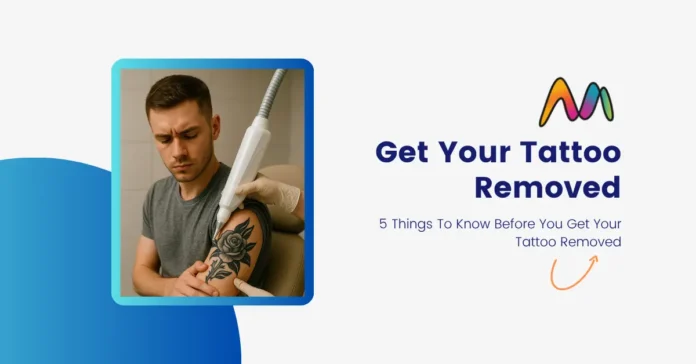Thinking about getting your tattoo removed? Perhaps you’re going through the “Tattoo Regret Phase”, or maybe you want to make room for new ink, or just enjoy clear, tattoo-free skin again. Whatever your reason, tattoo removal is a significant decision that requires preparation, patience, and realistic expectations.
Before you book your first session, here are five essential things to know before getting your tattoo removed, backed by expert advice and real experiences.
1. It Takes Multiple Sessions—Be Patient
Tattoo removal is not a “one-and-done” procedure. Laser tattoo removal typically requires multiple sessions spaced 4 to 8 weeks apart, depending on several factors like:
-
The size and complexity of the tattoo
-
Type and color of ink used
-
Depth at which the ink is embedded
-
Your skin type and immune system response
A black ink tattoo on fair skin may fade in 5-8 sessions, whereas colorful or layered tattoos may take 10 or more sessions for effective fading. The time between sessions allows the skin to heal and your lymphatic system to flush out the broken-down ink particles.
2. Tattoo Location Affects Fading Speed
Yes, location matters—a lot! Tattoos that are closer to the heart (like the chest or upper arm) tend to fade faster because of better blood circulation. On the other hand, tattoos on lower legs, feet, hands, or fingers may take more time to respond to laser treatments.
Why? Because blood flow plays a critical role in carrying away ink particles broken up by the laser.
3. Ink Color and Type Make a Difference
Not all inks are created equal. Black ink absorbs all laser wavelengths and is the easiest to remove. However, green, blue, yellow, and red inks can be stubborn and require specialized laser wavelengths.
In addition, amateur tattoos often fade more easily than professional ones, as they are typically not embedded as deeply in the dermis.
4. Expect Temporary Side Effects Post-Treatment
Post-session side effects are normal and part of the healing process. Common temporary side effects include:
-
Blisters
-
Swelling
-
Redness
-
Scabbing
-
Darkening or raising of the tattoo temporarily
Most of these side effects resolve within a few days to weeks. However, if symptoms persist or worsen, it’s best to consult your removal specialist or dermatologist.
5. Be Aware of Hypo-Pigmentation Risks
Laser tattoo removal can sometimes cause hypo-pigmentation—a condition where the skin loses its natural pigment, appearing lighter than the surrounding area. This is more common in people with darker skin tones due to how the laser interacts with melanin.
To minimize this risk, choose an experienced dermatologist or licensed laser technician who uses the right laser technology for your skin type.
🔍 Bonus Tip: Always Schedule a Consultation First
Before committing to a treatment plan, book a consultation with a certified tattoo removal clinic. This helps assess your tattoo, skin type, and medical history and set realistic expectations for results, duration, and cost.
FAQ
Q1. Is laser tattoo removal painful?
How much does tattoo removal cost?
Can all tattoos be completely removed?
Can I get a new tattoo over the old one after removal?
Are there any alternatives to laser tattoo removal?
✍️ In Conclusion
Tattoo removal is a process that involves time, care, and professional guidance. Whether you’re motivated by a career change, personal growth, or just a change of heart, make sure you’re informed and prepared before starting your tattoo removal journey.
👉 Always choose a certified technician, follow aftercare strictly, and keep your expectations realistic.


